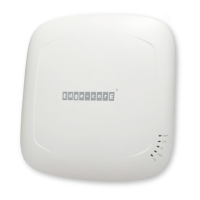
Do you have a question about the Edge-Core ECW5410-L and is the answer not in the manual?
| Brand | Edge-Core |
|---|---|
| Model | ECW5410-L |
| Category | Wireless Access Point |
| Language | English |
Guides users through the initial login process to the AP's web management interface.
Configures essential system details like name, description, location, and time settings for the AP.
Details steps for configuring network interface settings and enabling Wi-Fi access.
Configures system name, description, location, and time synchronization settings.
Manages IP address, subnet mask, gateway, and DNS settings for the AP.
Configures LAN port settings, including VLAN ID and CAPWAP tunnel interface.
Sets up the DHCP server for assigning IP addresses to connected clients.
Configures VLAN for management, SNMP, Syslog, and Management IP List.
Configures CAPWAP protocol for controller-based management and AP discovery.
Sets up AP to send all traffic to controller for centralized management.
Directs user authentication traffic to controller; data traffic bypasses tunnel.
Enables and configures IPv6 addressing for the device.
Configures the AP as an iBeacon transmitter for location awareness services.
Integrates AP with RTLS server for Wi-Fi based location and navigation.
Enables DPI DNS for WiFi marketing analytics and traffic analysis.
Displays overall status of Virtual Access Points (VAPs) and links to configure each.
Configures global wireless parameters for RF cards, bands, protocols, and channels.
Configures individual Virtual Access Points (VAPs) with SSID, network mode, and VLAN.
Sets up wireless security types like Open, WEP, WPA-Personal, and WPA-Enterprise.
Configures WDS links to extend wireless network coverage.
Adjusts parameters to improve network performance like RTS, fragmentation, and DTIM.
Restricts client connections by number or MAC address, or uses RADIUS authentication.
Configures Hotspot 2.0 (Passpoint) for enhanced public Wi-Fi services.
Scans and displays surrounding access points for connection management.
Manages firewall rules to block or pass Layer 2 traffic based on defined criteria.
Defines and manages firewall services (protocols and ports) for rule creation.
Configures advanced security enhancements for DHCP and ARP traffic.
Exposes specific internal services to the internet via port forwarding.
Allows a specific host to be exposed to the internet for special-purpose services.
Secures the web management interface by changing the default password.
Backs up and restores AP configurations, or resets to factory defaults.
Updates the AP's firmware via WMI or TFTP server.
Restarts the Access Point to apply changes or resolve issues.
Configures certificates for CAPWAP security validation and authentication.
Performs background scanning of the wireless environment without service interruption.
Helps discover APs and retrieve their IP, MAC, and other configuration details.
Provides tools like Ping, Trace Route, and Arping for network diagnostics.
Provides a summary of the AP's system status, radio, LAN, and CAPWAP information.
Displays traffic information (packets in/out, traffic in/out) per interface.
Monitors connected clients, their signal strength, and traffic statistics.
Shows IP addresses leased by the AP's DHCP server when in NAT mode.
Displays the status and performance metrics of Wireless Distribution System (WDS) links.
Records system events for monitoring and troubleshooting.
Tracks client association and WDS connection activities.
Visualizes AP performance metrics like CPU, memory, and associated stations.
Provides an overview of UPnP status, including port mapping details.
Connects to the AP's console port using serial cables for direct management.
Accesses the AP's console interface remotely using SSH for management and reset.
